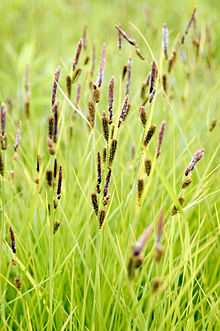Carex stricta
| Carex stricta | |
|---|---|
 | |
| Conservation status | |
| Scientific classification | |
| Kingdom: | Plantae |
| (unranked): | Angiosperms |
| (unranked): | Monocots |
| (unranked): | Commelinids |
| Order: | Poales |
| Family: | Cyperaceae |
| Genus: | Carex |
| Species: | C. stricta |
| Binomial name | |
| Carex stricta Lam. | |
| Synonyms | |
| |
Carex stricta is a species of sedge known by the common names upright sedge[1] and tussock sedge.[2] It is grass-like and can be difficult to distinguish from other plants, because of its long, triangular, green stems. The plant grows in moist marshes, forests and alongside bodies of water.[3] It grows up to 2 feet (0.61 m) tall and 2 feet (0.61 m) wide. When the leaves die, they build on top of or around the living plant, making a "tussock".[3] It is one of the most common wetland sedges in eastern North America.[4]
Just like with Taraxacum plants, their seeds are carried by the wind. When seeds land, they are eaten by birds such as dark-eyed junco, northern cardinal, wild turkey, and ducks such as mallard and wood duck. The seeds are also eaten by squirrels and other mammals.[3] The plant can also reproduce vegetatively via rhizomes, and often form colonies.[3]
References
- ↑ "Carex stricta Lam., upright sedge". PLANTS Profile. United States Department of Agriculture. Retrieved May 22, 2013.
- ↑ Coladonato, M. 1994. Carex stricta. In: Fire Effects Information System, USDA Forest Service Rocky Mountain Research Station, Fire Sciences Laboratory.
- ↑ 3.0 3.1 3.2 3.3 Carex stricta. Study of Northern Virginia Ecology. Fairfax County Public Schools.
- ↑ Carex stricta. Flora of North America.
